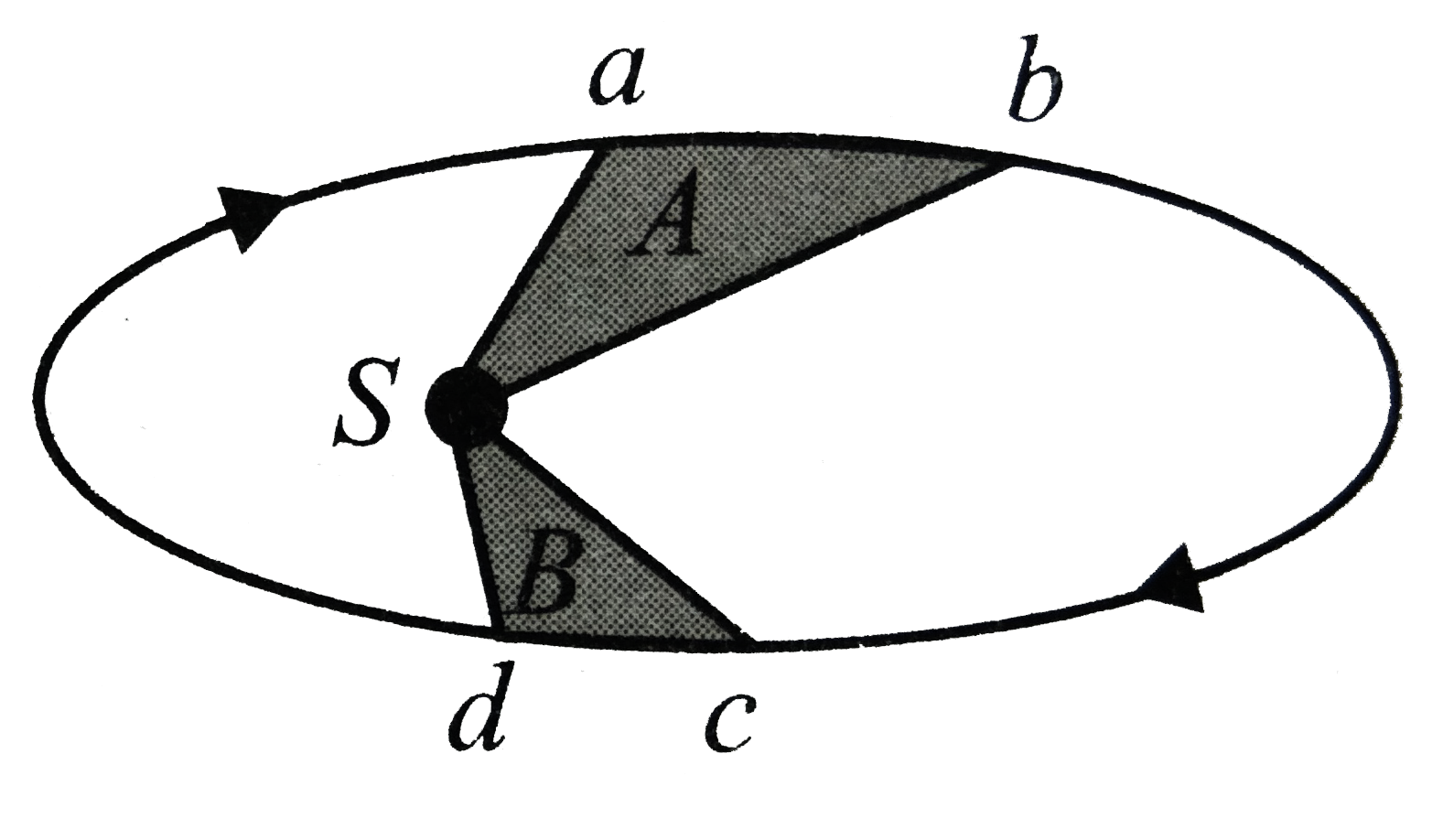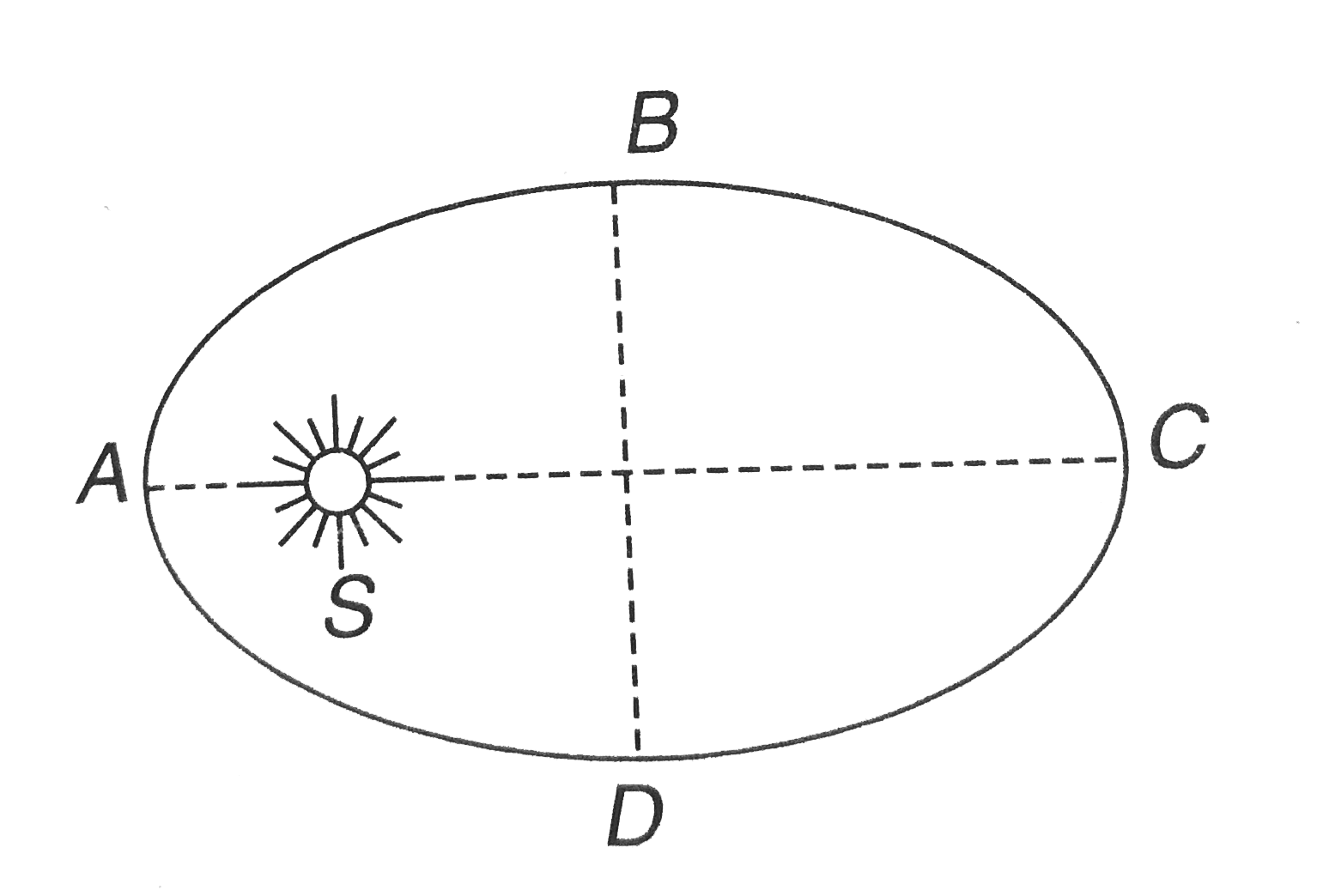Complete Solutions to Kepler’s Laws of Planetary Motion of chapter GRAVITATION of Class 11 book with complete answers and questions
| Class 11 | PHYSICS |
| Chapter | GRAVITATION |
| ERRORLESS | Kepler’s Laws of Planetary Motion |
| Number Of Questions | 51 |
| Academic Year | 2023-24 |
The distance of Neptune and Saturn from the Sun are respectively `10^(13)` and `10^(12)` meters and their periodic times are respectively `T_n` and `T_s`. If their orbits are circular, then the value of `T_n//T_s` is
03:30View SolutionFigure shows the motion of a planet around the Sun `S` in an elliptical orbit with the Sun at the focus. The shaded areas `A` and `B` are also shown in the figure which can be assumed to be equal. If `t_(1)` and `t_(2)` represent the time taken for the planet to move from `a` to `b` and `c` to `d`, respectively then
 01:19View Solution
01:19View SolutionThe period of a satellite in a circular orbit of radius `R` is `T`, the period of another satellite in a circular orbit of radius `4R` is
01:39View SolutionOrbit of a planet around a star is
01:22View SolutionIf a body describes a circular motion under inverse square field, the time taken to complete one revolution T is related to the radius of the circular orbit as
03:39View SolutionIf the earth is at one-fourth of its present distance from the sun, the duration of the year would be
02:29View SolutionThe earth revolves about the sun in an elliptical orbit with mean radius `9.3xx10^(7) m` in a period of 1 year. Assuming that there are no outside influences
03:36View SolutionVenus looks brighter than other planets because
01:16View SolutionA planet moves around the sun. at a given point `P`, it is closest from the sun at a distance `d_(1)`, and has a speed `V_(1)`. At another point `Q`, when it is farthest from the sun at a distance `d_(2)`, its speed will be
04:10View SolutionThe orbital speed of Jupiter is
02:18View SolutionTwo planets move around the sun. The periodic times and the mean radii of the orbits are `T_(1), T_(2)` and `r_(1) r_(2)` respectively. The ratio `T_(1)//T_(2)` is equal to
04:12View SolutionAccording to Kepler's second law, the radius vector to a planet from the Sun sweeps out equal areas in equal intervals of time. This law is a consequence of the conservation of ______________.
01:04View SolutionThe largest and the shortest distance of the earth from the sun are `r_(1)` and `r_(2)`, its distance from the sun when it is at the perpendicular to the major axis of the orbit drawn from the sun
06:04View SolutionThe rotation period of an earth satellite close to the surface of the earth is 83 minutes. The time period of another earth satellite in an orbit at a distance of three earth radii from its surface will be
02:42View SolutionA satellite of mass `m` is in a circular orbit of radius `r` round the Earth. Calculate its angular momentum with respect to the centre of the orbit in terms of the mass `M` of the Earth and `G`.
04:21View SolutionAccording to Kepler, the period of revolution of a planet ( T ) and its mean distance from the sun ( r ) are related by the equation
02:02View SolutionA planet revolves around sum whose mean distance is `1.588` times the mean distance between earth and sun. The revolution time of planet will be
02:36View SolutionA satellite A of mass m is at a distance of r from the centre of the earth. Another satellite B of mass 2m is at distance of 2r from the earth's centre. Their time periode are in the ratio of
03:12View SolutionThe earth `E` moves in an elliptical orbit with the sun `S` at one of the foci as shown in figure. Its speed of motion will be maximum at the point
 01:52View Solution
01:52View SolutionThe time of revolution of planet `A` round the sun is `8` times that of another planet `B`. The distance of planet `A` from the sun is how many `B` from the sun
02:39View SolutionIf the radius of earth's orbit is made 1/4, the duration of an year will become
02:19View SolutionThe motion of planets in the solar system is an exmaple of the conservation of
02:33View SolutionIf mass of a satellite is doubled and time period remain constant the ratio of orbit in the two cases will be
01:02View SolutionThe earth revolves round the sun in one year. If the distance between them becomes double, the new period of revolution will be
02:05View SolutionKepler discovered
01:46View SolutionIn the solar system, which is conserved
03:10View SolutionThe maximum and minimum distance of a comet form the sun are `8xx10^(12)m and 1.6xx10^(12)m`. If its velocity when nearest to the sun is `60m//s`, what will be its velocity in m/s when it is farthest
03:07View SolutionA body revolved around the sun 27 times faster then the earth what is the ratio of their radii
03:14View SolutionThe period of moon's rotation around the earth is approx. 29 days. IF moon's mass were 2 fold its present value and all other things remain unchanged, the period of Moon's rotation would be nearly
02:08View SolutionTwo planets at mean distance `d_(1)` and `d_(2)` from the sun and their frequencies are n and n respectively then
02:18View SolutionWhich of the following astronomer first proposed that sun is static and earth rounds sun
01:02View SolutionThe distance of a planet from the sun is 5 times the distance between the earth and the sun. The time period of the planet is
02:29View SolutionA planet is revolving around the sun as shown in elliptical path. The correct option is
 02:34View Solution
02:34View SolutionIn the previous question, the orbit velocity of the planet will be miniumu at
02:42View SolutionThe radius of orbit of a planet is two times that of the earth. The time period of planet is
02:23View SolutionThe orbital angular momentum of a satellite revolving at a distance r from the centre is L . If the distance is increased to 16 r, then the new angular momentum will be
01:52View SolutionAccording to Kepler’s law the time period of a satellite varies with its radius as
01:57View SolutionIn planetary motion the areal velocity of possition vector of a planet depends of angular velocity `(omega)` and the distance of the planet from sun (r). If so the correct relation for areal velocity is
02:58View SolutionThe ratio of the distances of two planets from the sun is 1.38. The ratio of their period of revolution around the sun is
03:13View SolutionKepler's second law is a consequence of
02:44View SolutionIn an elliptical orbit under gravitational force, in general
04:06View SolutionIf a new planet is discovered rotating around Sun with the orbital radius double that of earth, then what will be its time period (in earth's days)
02:12View SolutionSuppose the law of gravitational attraction suddenly changes and becomes an inverse cube law i.e. `F prop 1//r^(3)`, but still remaining a central force. Then
View SolutionWhat does not change in the field of central force
02:36View SolutionThe eccentricity of the earth's orbit is `0.0167`, the ratio of its maximum speed in its orbit to its minimum speed is
06:44View SolutionWhat is the mass of the planet that has a satellite whose time period is `T` and orbital radius is `r`?
01:23View SolutionIf the orbital velocity of a planet is given by `v = G^(a) M^(b) R^(c )` then find the value of a, b and c ?
03:50View SolutionHubble's law states that the velocity with which milky way is moving away from the earth is proportional to
01:41View SolutionTwo satellite are revolving around the earth with velocities `v_(1)` and `v_(2)` and in radii `r_(1)` and `r_(2)(r_(1) gt r_(2))` respectively. Then
01:39View SolutionThe condition for a uniform spherical mass `m` of a radius `r` to be a black hole is [`G` =gravitational constant and `g`=acceleration due to gravity]
01:42View SolutionEarth is revolving around the sun if the distance of the Earth from the Sun is reduced to 1/4th of the present distance then the present day length reduced by
01:42View Solution
Kepler’s Laws of Planetary Motion questions and complete solutions for chapter GRAVITATION of UNIVERSAL BOOK DEPOT 1960 PHYSICS (HINGLISH) of Class 11
